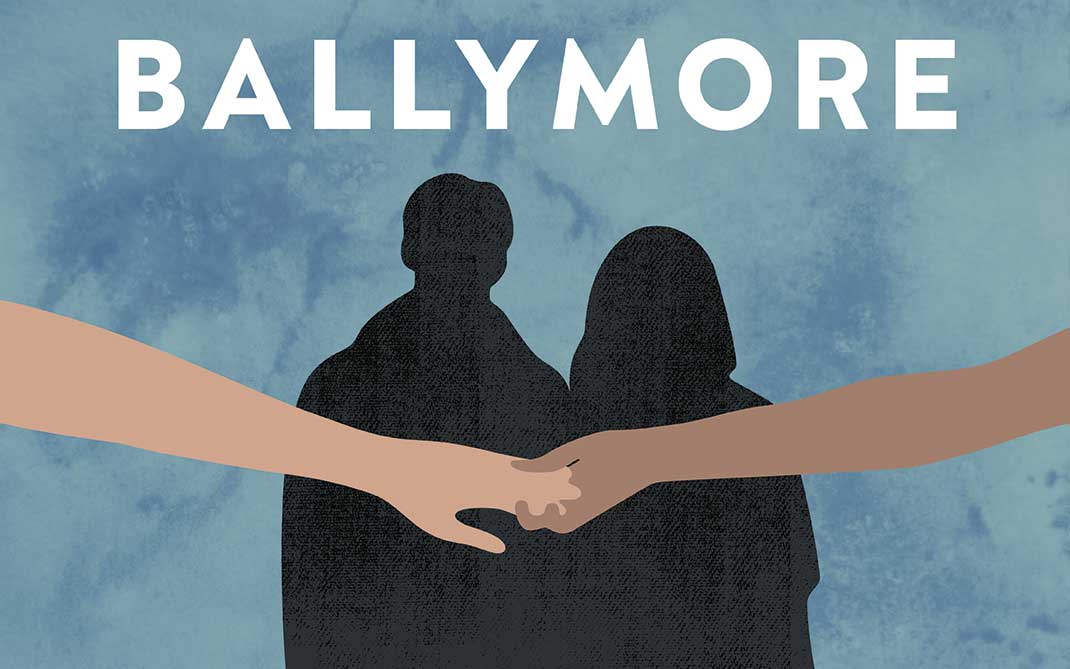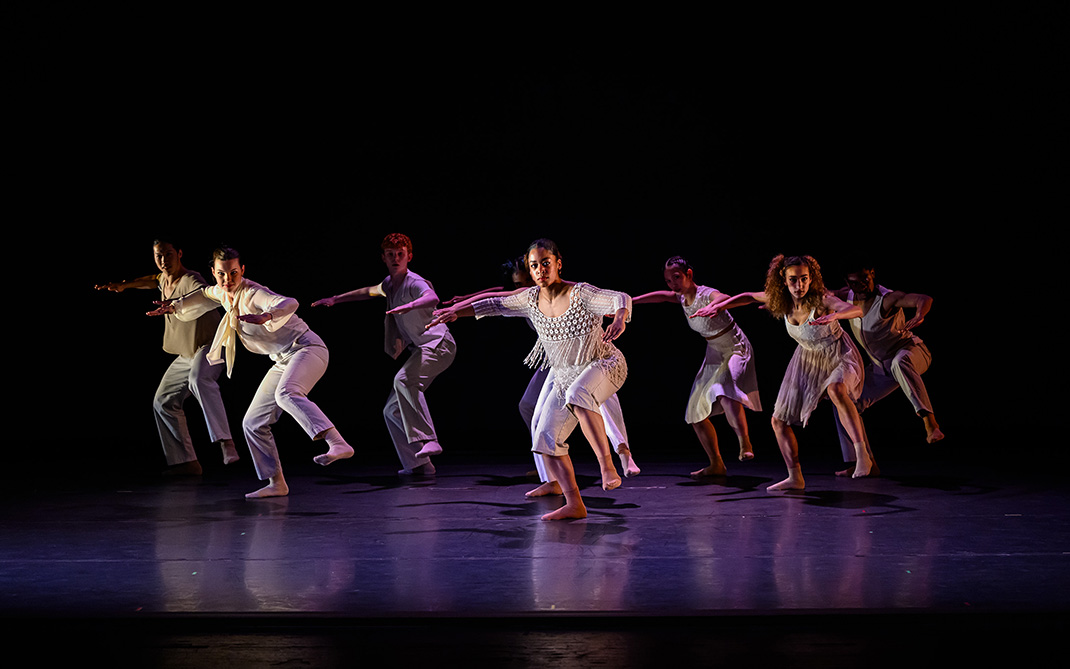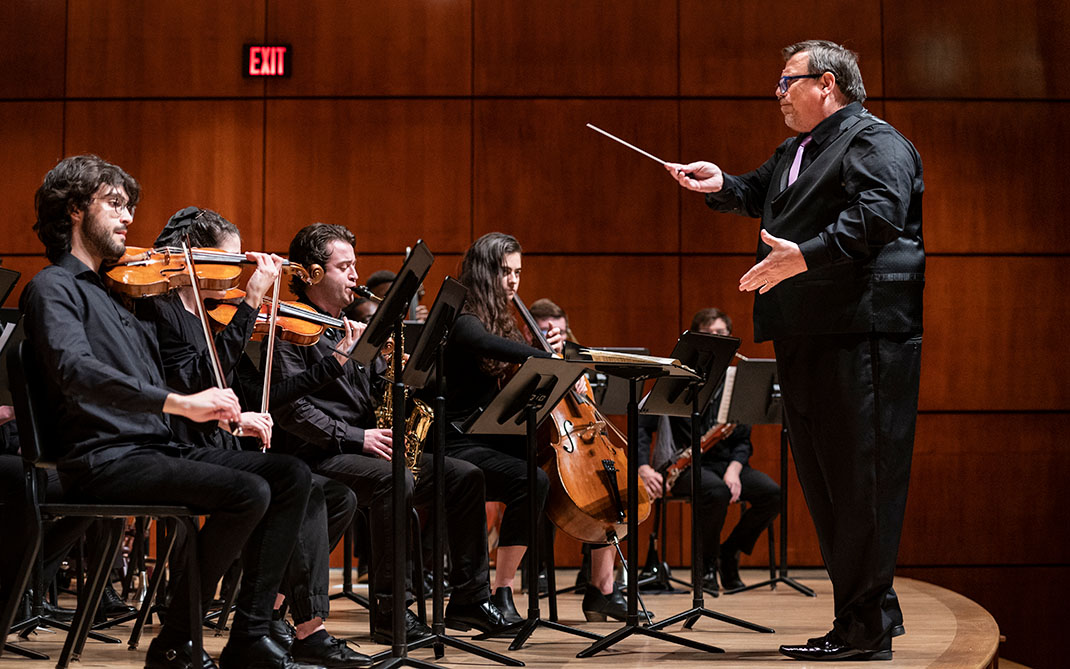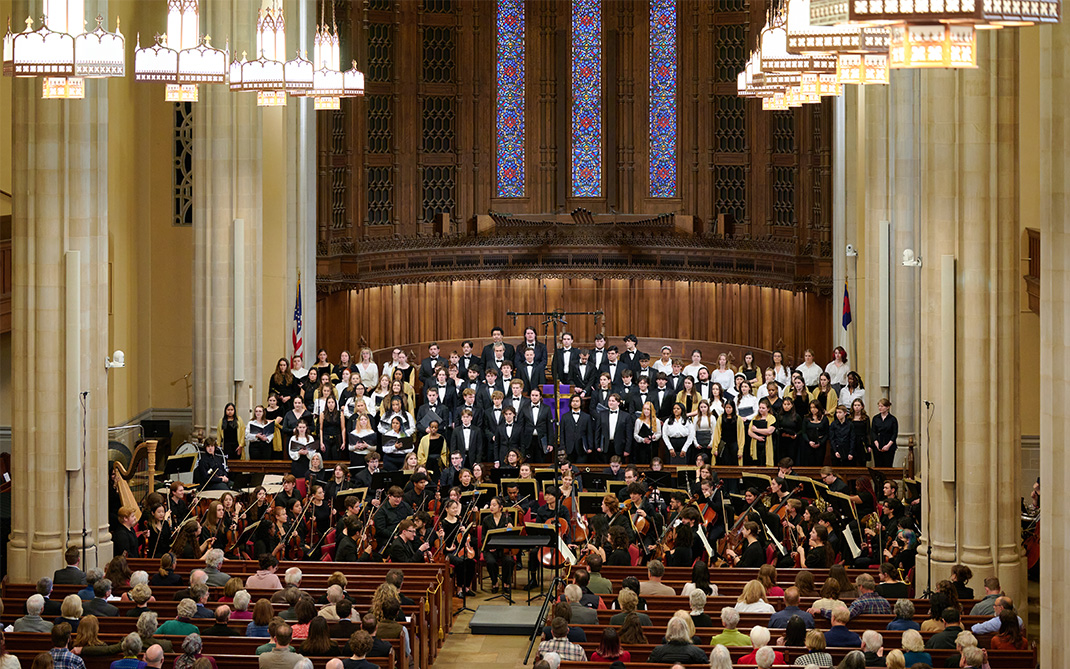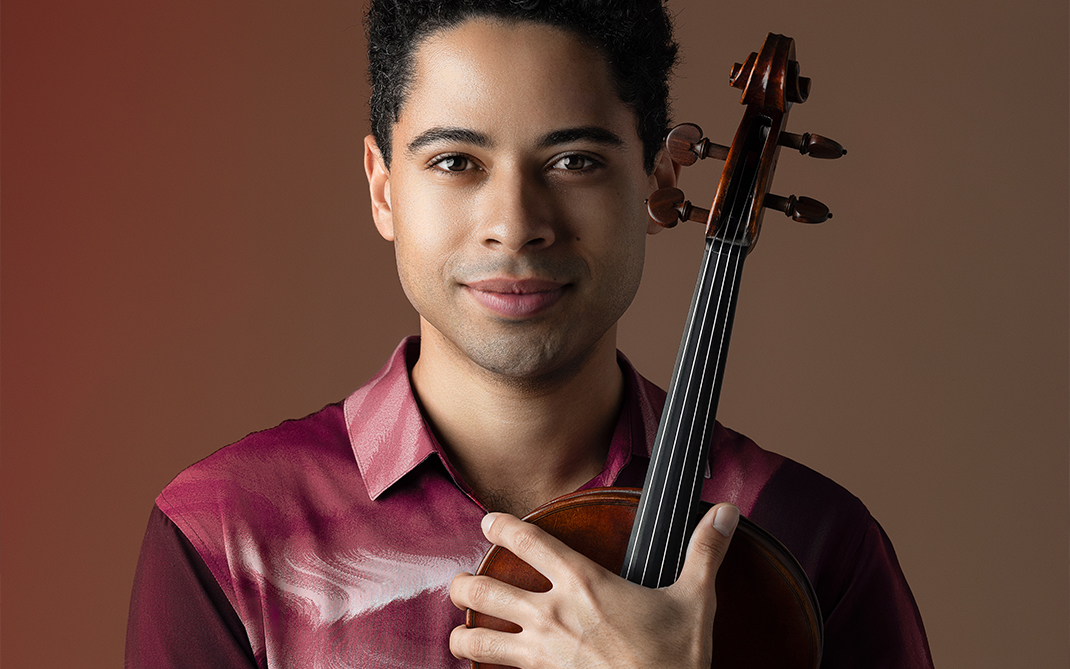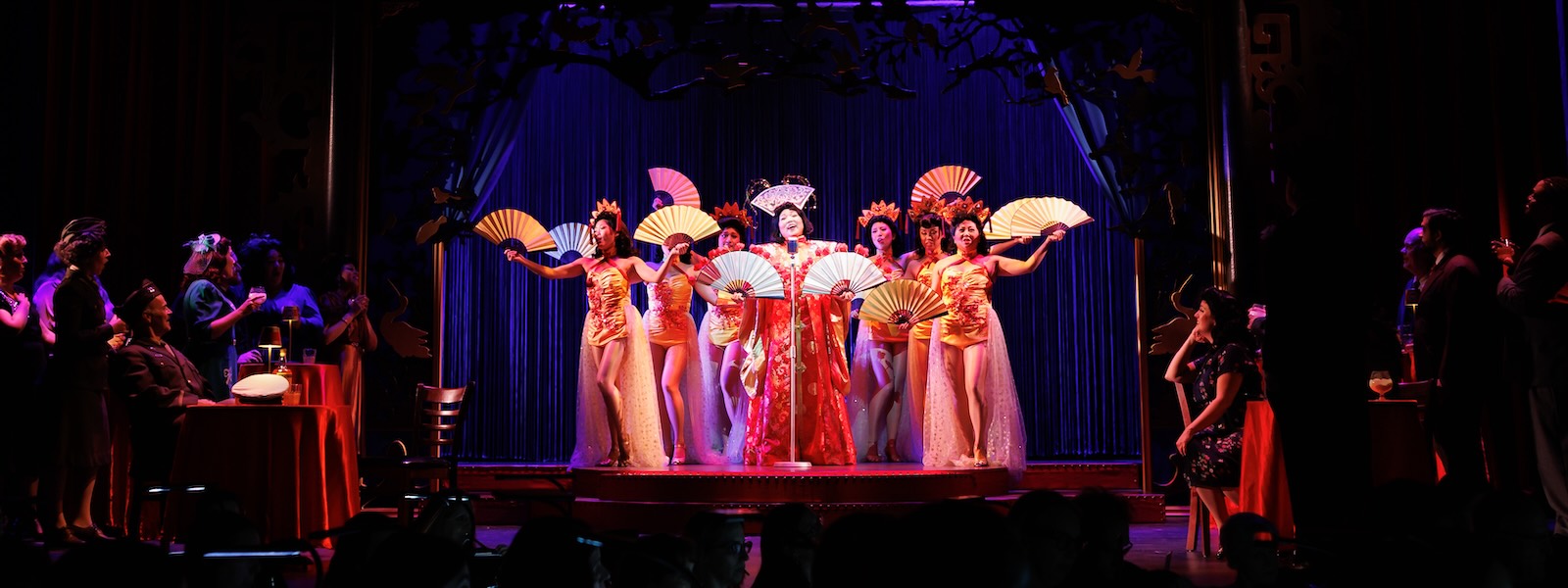Phil Chan
The views and opinions expressed by speakers and presenters in connection with Art Restart are their own, and not an endorsement by the Thomas S. Kenan Institute for the Arts and the UNC School of the Arts. This interview has been edited for length and clarity.
Phil Chan is a choreographer, director and ballet scholar who seven years ago decided to turn a longstanding frustration into a wellspring of activism. Although American entertainment had made great progress in eliminating the use of blackface, demeaning and wildly inaccurate depictions of Asians and Asian-ness continued to appear on ballet stages.
He therefore teamed up with prima ballerina Georgina Pazcoguin to create Final Bow for Yellowface, an organization that started working with ballet companies in America and Europe to eliminate offensive depictions of Asians in their repertoires and help them find inventive and respectful ways to stage culturally problematic ballet classics.
Their work has paid off, notching up notable successes here and abroad and changing the culture in ballet companies to value and welcome a broad array of artists. Phil distilled his ethos and tactics in his book “Final Bow for Yellow Face: Dancing Between Intention and Impact.”
As a director and choreographer, Phil has put his own stamp on once-problematic Orientalist standards. Last year, he directed “Madama Butterfly” at Boston Lyric Opera in a production that The Boston Globe called “an invigorating and meaningful reclamation of Puccini’s beloved opera.” Earlier this year he co-choreographed with Doug Fullington the ballet “La Bayadère” at Indiana University, maintaining Marius Petipa’s choreography but moving the setting from a 19th century India sprung from a European imagination to the homegrown American exoticism of 1920s Hollywood.
In this interview, Phil describes how he developed the mission and methods of Final Bow for Yellowface and explains how reexamining the standard ballet repertoire through a multicultural contemporary lens honors and benefits the artform as a whole.
Choose a question below to begin exploring the interview:
- When you were coming up as a ballet dancer, what were you experiencing as a young Asian dancer?
- How did you and your co-founder develop what Final Bow eventually became? What was first on your to-do list?
- When you were first approaching companies, what were some of the most common walls that you would hit?
- Can you describe the moment you were asked to direct “Madama Butterfly?” Was that exciting? Terrifying? What was your first take on it going to be?
- I also want to talk about your recent choreographic work “La Bayadère,” which you recently did at the University of Indiana. What really interested me about this was your balancing tradition and innovation.
- Imagine that there is a time when Final Bow for Yellowface is no longer needed. What would that feel like for an Asian American artist working in the performing arts? How would it be different from them?
Pier Carlo Talenti: I’d love to talk about you when you were coming up as a ballet dancer, when Final Bow for Yellowface was on the distant horizon. What were you experiencing as a young Asian dancer?
Phil Chan: I just distinctly remember going to see “The Nutcracker” with my dad. I was pretty young. After the Chinese dance, he turned to me and said, “Is this really what you want to do? Because this will be all that you will ever be seen as.” It was just the sort of thing where you didn’t really see it in the same way until … . Because everyone’s doing it, and it can’t be wrong if everyone’s doing it. And as a young dancer, you don’t really always have the right vocabulary to talk about it. I distinctly remember that.
Also graduating from college and moving to New York City, I was 20, and I wanted to be a choreographer. I looked at the two big ballet companies here in New York City, American Ballet Theater and New York City Ballet, and ABT, I think, had hired one Asian choreographer since its inception. The artistic director at the time had hired zero during his tenure. New York City Ballet had yet to hire Ed Liang, who was the first Asian choreographer invited to make work, and that happened in the last five, 10 years. So just seeing that “Oh no, the door is not open for someone like you. They aren’t interested in your ideas” made me put that dream on sort of a back burner because that wasn’t something that I felt was open to me.
Pier Carlo: So you were dancing, but you were putting your dreams of becoming a choreographer on the back burner.
Phil: Sure, sure. I think it really came to a head when there was a beautiful production of “Sleeping Beauty” choreographed by Alexei Ratmansky, reconstructed from notation. As a dance-history nerd, I was really excited about seeing this production, and it premiered at ABT, I think, in 2015. I remember really enjoying it until the third act. There’s this sort of porcelain prince and princess who come out, bobbing and shuffling in a stereotypical Chinese way, and it just felt like, “Oh God, do we really need that when we’re restoring the classics?”
Pier Carlo: So this production had been reinvented in some other ways but not that one?
Phil: Well, no. He was restoring this original production, which did have this sort of Chinese porcelain prince and princess, but I just felt like, “Oh, just because we’re going back in time, do we really need to recreate this sort of Oriental caricature?”
It really came to a head when the artistic director of New York City Ballet, Peter Martins, called me in 2017. My very good friend, Georgina Pazcoguin, who was the first Asian woman to be promoted to soloist at New York City Ballet, was in a diversity committee meeting, and the topic of the Chinese dance came up and she slipped Peter Martins my phone number. He wanted to talk to me because I both knew the ballet inside and out but also had the lived experience of being Chinese, living in the minority here in America and what the impact of this dance could be.
We talked about the Chinese variation of “The Nutcracker” and the history of Asian people being represented and the history of ballet itself, what cultures were part of the development of this artform which came from the Italian and French courts, incubated in Russia and found a new home here in America. What cultures contributed to this? I left that meeting and basically called Gina and said, “I think Peter’s going to make some subtle changes to ‘The Nutcracker.’”
It was really in that moment that we realized we had a choice. We could either just quietly go back into the night and say, “Great job, New York City Ballet.” But we were also looking around at the rest of the landscape and saying, “Wow, so many companies are saying, ‘Yes, diversity, equity, inclusion. Yes, we want non-European folks to come into this artform and feel included.’ But, ‘Yeah, ching-chang-chong, here’s your culture. Sorry, we’re not willing to change it because that’s tradition and that’s our heritage.’” It felt like those two things were not congruent.
You can’t say to my Indian neighbor, for example: “Hey, Mrs. Singh, can you please drop off your kids at our ballet school and become a subscriber, become a donor, join our board? But here’s a version of your culture onstage that is caricatured and incorrect and based on what Europeans thought they knew about your culture from 150 years ago. And that’s too bad, sorry, because it’s art and we can’t change it, even though we’re about to go onstage tonight and do this show, which has never been done this way before. But sorry, let us know when we can expect your check.” It doesn’t work that way.
So how do we change this artform from being strictly Eurocentric to being a global artform, which includes white Americans, right? White Americans are not Europeans. We’re not doing ourselves any favor by just sticking to how Europe saw the world 200 years ago. Our performing arts, which are supposed to be living, breathing, art experiences, if they don’t reflect who we are, then it doesn’t feel good, it doesn’t feel real.
That’s the mission of Final Bow for Yellowface, really figuring out how to shift from a strictly Eurocentric way of doing ballet to something that’s global.
Pier Carlo: So how did you and your co-founder, Georgina, develop what Final Bow eventually became? What was first on your kind of to-do list?
Phil: We were just thinking about this idea of activism in general. Basically every small town in America has a “Nutcracker” production, so how do we get everybody to think about this differently? We realized that we only actually had to change the minds of maybe even 10 people, and these 10 people represented the top ballet companies in America, the artistic directors. If we changed their minds and got people talking about this, we could create a trickle-down effect to smaller companies, to dance schools, and have this be a larger conversation.
We bought Yellowface.org — it was $11 at the time — and we put up a simple pledge, which essentially says, “I love ballet, and because I want it to be bigger, I’m not going to do yellowface on our stages.” We felt like using this tone, instead of going after people, having this resource there —
How do we change this artform from being strictly Eurocentric to being a global artform, which includes white Americans, right? White Americans are not Europeans. We’re not doing ourselves any favor by just sticking to how Europe saw the world 200 years ago.
Pier Carlo: The vision is inherently expansive.
Phil: Yeah. And we’re also practicing inclusive advocacy. We’re not saying, “Hey, you’re a racist; you need to change.” We’re saying, “Hey, we who love ballet, we need to fix this. We need to get together and figure out a solution to this.” But we also offered solutions. There are constructive solutions that we offered on the website so that people could think about it and come to this conclusion.
Then we started quietly going to ballet companies, saying, “Hey, Peter Martin’s just changed ‘The Nutcracker.’” This was sort of February of 2018. He had just changed it. And I said: “Nobody wants to talk about ‘The Nutcracker’ in February, but here’s the deal. We’re all collectively deciding this coming year that we’re not going to do yellowface. Here’s a list of companies that have already pledged. Would you like to join us? And if you haven’t had that conversation yet, now’s the time. You have nine months, 10 months to get whatever choreographic trusts your version comes from to be approved or approved by the choreographer. You have time to go to your board and say, ‘Hey, can we have a little bit of extra budget for new costumes?’ You can create new rehearsal time. You can find a plan B for what you’ve usually been doing. We’re telling you now so you can actually take action.”
That first year, we got a lot of small companies, big companies, medium companies, to sign on board. Pretty much at this point now, since 2017, pretty much every major American ballet company has signed the pledge. A lot of the large European companies are signing this and having this conversation. Actually, right now, the Paris Opera, which is the West’s oldest continuous performing-arts organization, founded by Louis XIV, they had their first diversity report a couple of years ago, and they cited our work by name as a contributing factor to their decision to no longer do blackface or yellowface on their stages, both in the opera and the ballet.
Pier Carlo: Congratulations.
Phil: Thank you. Despite the fact that we’ve had this laser focus on the Asian experience, it’s had this beautiful ripple effect of saying, “How do we see each other better? How do we portray each other with more nuance and more humanity? Because art is supposed to build empathy with people. So how can we do that across racial lines so that the work has more integrity?” So that’s really the place where we’re at with this work right now.
Pier Carlo: When you were first approaching companies, what were some of the most common walls that you would hit, if any?
Phil: The big thing was, “I’m sorry, this is tradition; this is heritage.”
Pier Carlo: And this is what “our audience” expects.
Phil: Right. I think about just the performing arts in general. We have to treat the performing arts differently than we treat the visual arts or the static arts. Film, painting, photography, sculpture, those are frozen in time. An artist made that thing, and it really captures the zeitgeist of a moment. You have to judge the Mona Lisa as a product of its time in the same way you look at a film like “The Birth of a Nation” as a cultural product of its time. You can’t change it. No one’s asking you to do a remake of “The Birth of a Nation.” I don’t want to see it on CBS for Christmas, you know? But it is an artifact.
Whereas with the performing arts, we have to treat it like a living being, almost like being a gardener. It needs to get a little messy. You need to have pollinators. You need to prune it once in a while to keep its shape because it’s this living thing. And if you just look at Shakespeare, I mean, if you’ve ever seen a Shakespearean play set other than the time Shakespeare wrote it, you are already seeing something radical. If you’re seeing a woman onstage, you are already seeing something radical in a Shakespearean play.
If you look at the evolution of ballet itself, tutus have gotten shorter. Sometimes there were no women allowed to do ballet. Sometimes men were not so hot in ballet. Nowadays, you can get your leg all the way up to your ear, and it’s not considered vulgar. We have other things like maternity leave, cross-training, nutrition, mental-health resources, all things that, say, 18th century ballerinas did not have access to. So this artform is changing. We train differently too.
If we are changing and our repertory is changing, then why can’t we change, especially if it means being better at getting more non-Europeans into the artform? How many versions of “The Nutcracker” have you seen? Tell me that change is not possible. How many versions of Balanchine’s “Apollo” have you seen? There’s like four or five versions out there. That’s OK. That means that we get more. Don’t we want that? Don’t we want it to be bigger?
Pier Carlo: You directed “Madama Butterfly” in Boston. In many ways that’s the epitome of European cultural appropriation or exoticization of “The East.” It’s such a hot potato. And of course, because of “Miss Saigon,” it’s a hot potato twice over. Can you describe the moment you were asked to direct it? Was that exciting? Terrifying? What was your first take on it going to be?
Phil: I heard from Brad Vernatter, who’s the general director of the Boston Lyric Opera. This was in, I guess, 2020, 2021. Essentially, Boston Lyric Opera had been planning on doing a production of “Madama Butterfly” that was canceled due to COVID. They were trying to redo it the following season, but then there was this huge surge in this anti-Asian hysteria, and they weren’t really sure that they were able to stage this work with integrity, essentially a tragedy about an Asian woman when real Asian women outside were being followed home and stabbed and pushed in front of subways and spat on, etc.
Pier Carlo: Shot at.
Phil: Right. So how to do it? They approached me about hosting a series of conversations called “The Butterfly Process” — which is still available on BLO’s website — essentially asking the question, “What’s wrong with ‘Butterfly’? What’s good about ‘Butterfly’ that’s worth keeping? And what’s a way forward for this work?”
We also wanted to not just talk to creatives, singers and directors but also to historians, scholars, people from all different angles of “Madama Butterfly,” lots of people who were stakeholders, board members, regular audience members. “What’s your relationship with this work?” We also centered Asian voices to really focus on the impact of this work when it’s done poorly or without integrity.
That really gave me a roadmap for how to pursue this work in this shift from going from Eurocentric to global or to multiracial.
Pier Carlo: Did those conversations convince you and the Lyric Opera to produce it, or was it set and you decided to have these conversations?
Phil: The conversation was supposed to inform an upcoming production of “Butterfly.” In the midst of the conversation, Brad just asked me, “What would you do with this story? Really, from a creative standpoint, how would you save ‘Butterfly?’” I’d really been thinking that through for myself just to see if it was possible as a thought exercise, but I’d had no idea that I would even be a person to direct an opera like this. I’d always been fascinated about what else it could be, which is my favorite creative prompt. That really is my guiding north star in terms of my practice: What else could it be?
So what’s a geisha story? Geisha in Japanese means artist. So what else could it be? An artist. OK, could she be a jazz singer? OK, what does that mean? I was also thinking a lot about Nagasaki. Of course, Puccini’s Nagasaki is very different than our Nagasaki. We dropped a bomb on it. That’s something that Puccini could have never envisioned, but probably the most defining geopolitical event that still defines our relationship with all of Asia is Japan in World War II.
Seeing that moment as a sort of congruent place to tell a story, I also was exposed to or introduced to Arthur Dong, who is an incredible filmmaker, and his film “Forbidden City, U.S.A.,” which is a brilliant short documentary. I highly recommend folks watch it. It’s about these San Francisco Chinatown nightclubs from the '20s to the '60s that featured Asian Oriental dancers. They had this sort of subversive marketing where they would say, “Oh, come and check out our Oriental blossoms, our beautiful Oriental girls.” You show up, and it’s just the same American dances you’d see at other clubs; they just happen to be Asian Americans. But this subversion of this sort of Oriental-ness … .
I just began to think, “OK, so 1940s San Francisco Chinatown.” And then, of course, the real defining experience for Japanese Americans was incarceration. Also how do we weave all of that into a story? Also, I’m not Japanese American. My family was not incarcerated. If anything, my grandfather hated the Japanese; we’re from mainland China, so he had his own prejudices and biases. So to do this story with integrity, I felt like it was something that even though I’m not Japanese American, as an American, this is our story that we all have to tell. We all have to share the burden of this responsibility of telling the story so that we don’t repeat it again.
Part of that too was collaborating with Japanese Americans to be able to tell that story. I had a brilliant colleague in Nina Yoshida Nelsen, whose family was incarcerated. She served as the dramaturg on this production. Working with her, a Chinese person and a Japanese person telling this fusion Chinese-Japanese-American story, it was just so rewarding. It felt like what we accomplished was not excusing Puccini’s white gaze but instead using his music to tell an Asian American story where Asian-ness was the center.
The response, I felt, was incredible. What I was most touched by was the response from Asian American people who came up to me and said, “I always cringe at ‘Butterfly,’ and this was the first time I felt like I could lose myself in the story and just appreciate the music.” Michael Sakamoto, who’s our choreographer, his father was born in a camp, and at the end of the opera, he stood up and said, “This is true. I saw it. I lived through this.” So just really figuring out a way to tell the story with integrity.
We didn’t change any of the Puccini. We didn’t hack it up or do anything crazy with it. If you close your eyes and listen, it’s the same that you’d hear at any other opera house, but it’s just done staged in a different way.
Pier Carlo: How much freedom did you allow yourself to take the libretto apart?
Phil: Well, I mean, it’s a whole new story.
Pier Carlo: Oh, it’s an entirely new story.
Phil: Yeah, yeah. It’s a congruent story.
Pier Carlo: There’s still a love story, I imagine.
Phil: Well, the love story is not the conventional one, because Pinkerton and Butterfly don’t really have a romance like in other operas. I mean, it’s even arguably not really a love story in the same way. But I found another love story in this opera, which was the love of a mother and her son. As you’re coming into the theater, before the opera starts, you see these two Japanese American women. They’re in their kitchen, and they’re baking a cake. It looks like a birthday cake. The opera starts, and you see that they’re having a birthday party for her son, for Butterfly’s son, whom she lost in camp. And you see the arc of the night she met his father to the moment that she loses her son in camp.
And it’s still a death. She didn’t literally die, but as any woman who’s experienced the loss of a child will tell you, yes, a part of you dies. It just felt like the impact at the end wasn’t just, “Oh, that’s too bad. That Oriental gal killed herself at the end because of honor, whatever. Oh, that’s so sweet. Where should we go for dinner, honey?” But this one instead says, “No, no, this is a story that all of us can relate to. It has happened to every family.” I just felt like it was keeping the impact of what Puccini wanted, but telling it in a way, again, with more integrity.
Pier Carlo: Are other operas producing your version?
Phil: Well, this was BLO’s production. I’m talking to a few other companies about doing this in the future, but yes, ideally other companies could pick up this production and do it in a city near you, so it might happen soon.
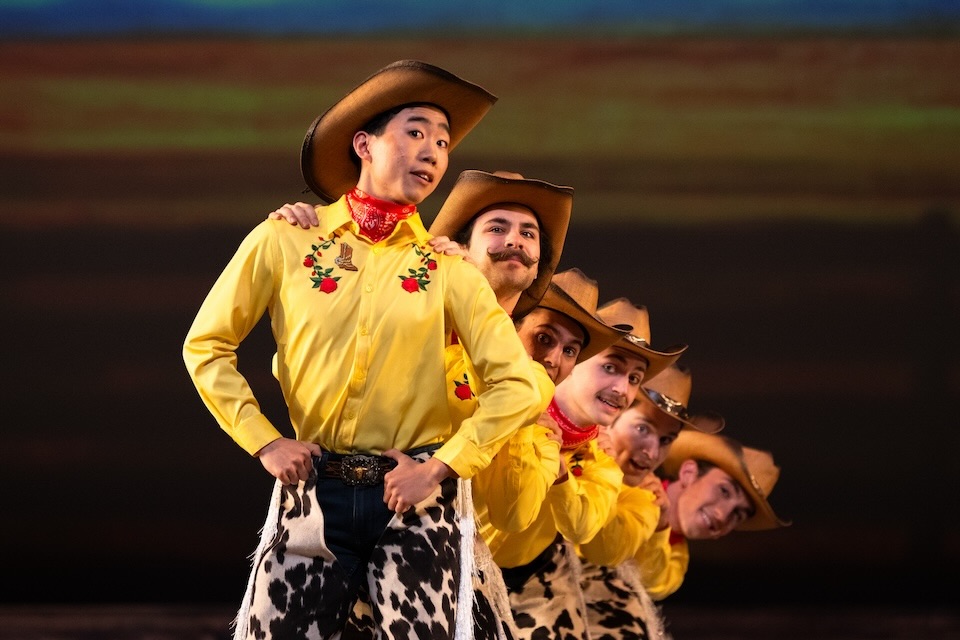
"Star on the Rise: La Bayadère ... Reimagined!" at Indiana University. Photo by Max Tortoriello.
Pier Carlo: I also want to talk about your recent choreographic work, specifically “La Bayadère,” which you recently did at the University of Indiana. What really interested me about this was your balancing tradition and innovation. You hired Doug Fullington, who specializes in 19th Century ballet —
Phil: To clarify, I did not hire Doug. Doug and I fully collaborated together on this production, so we stepped through that door together. Again, it went back to this “what else could it be” question. Doing Final Bow for Yellowface, I saw the writing on the wall that all these companies were not hiring Asian artists but instead sticking to these Orientalist depictions of Asians. We needed to find a new way forward; we needed to show people that there was a new way forward. And while we’ve seen so many productions of “Nutcracker” that have been reimagined, the Orientalist ballets have not really been touched that way.
Pier Carlo: Because “La Bayadère” is set in India, is that correct?
Phil: Yes, correct. For folks who aren’t familiar, it’s sort of like the “Aida” of ballet. There’s a temple dancer, Nikiya, who’s in love with the most noble warrior in the land, Solor, but he’s of course betrothed to Princess Gamzatti. So there’s sort of a melodramatic love triangle. It’s by Marius Petipa, who’s the same choreographer as “Swan Lake” and “The Nutcracker,” so it has some important historic value to it. It’s not a piece that you just want to say, “Well, it’s inherently racist. Let’s cancel it.”
I first met Doug when I was starting my Final Bow work, and he sent me an email with a dance, the Chinese variation that he had restaged from notation in the studio, the earliest version he could find. What I found was that the dance wasn’t Chinese-caricatured. It was quite charming and playful. Doug really gave me this very sweet gift at a moment when I was really doubting if this work was productive, to say, “Hey, no, look, it is possible to do this dance with heritage and tradition in mind but not in a caricatured or offensive way.” That’s how I first met Doug. I started working with him and talking to him about the potential of a work like “La Bayadère” and how we could not just treat a single variation that way but treat a whole ballet with a new congruent story that could not only show us the past but also shift it again from being a European’s view of exotic India to being a dance about us.
So what would that look like? We’d been chewing on this scenario of 1920s Hollywood, sort of a Busby Berkeley-inspired era. “Singin’ in the Rain” was a very important film that suggested a similar plot to us for this new imagined “Bayadère.” For Doug, I think one of the things he kept talking about was the steps in the notations that we were basing the production on from the early 20th century, the earliest notes that we could have on the ballet. It looks a little bit different than what most people know.
Pier Carlo: These were notes taken by a disciple of Petipa’s?
Phil: It was by Sergeyev, who was an expert in this notation. During the revolution, he brought all of these notes of all these classical ballets to Europe, and they currently are housed at Harvard. It’s from those notations that we’re restaging these ballets. So, it’s not like the productions you see, like Makarova’s or Nureyev’s productions, which are derived from a 1940 Soviet production. We went earlier than that.
We really had this commitment to history and tradition, but we wanted to find a way to still do that spectacle, colorful, exotic feel but make it about us, even though that feels like an oxymoron. You can’t be “exotic” and “us.” But how can we do that? We settled on, they’re filming a cowboy musical in Hollywood. It’s a Hollywood behind-the-scenes melodrama of a cowboy musical.
I was giving a lecture at Indiana University during COVID over Zoom, and Sarah Roth, who was the department chair there, was listening in. I mentioned this idea of a production that Doug and I had been chewing on, and she said, “Oh, who’s producing that?” I said, “Well, we haven’t found anyone yet.” And she said, “Oh, great. We’ll do it. Let’s do it in 2024.” Because they have to provide their students with this incredible opportunity. And I have to say, they’re probably one of the best college ballet programs in the country.
Pier Carlo: After ours, I’m sure. [He laughs.]
Phil: [Laughing] Yeah, you guys are up there too!
Pier Carlo: Imagine that there is a time when Final Bow for Yellowface is no longer needed, when all its goals have been met. What would that feel like for an Asian American artist working in the performing arts? How would it be different from them?
Phil: It’d be nice to be thought of as a choreographer and not just an Asian choreographer or an opera director and not an Asian opera director. I think we’re on our way there. It’s sort of two steps forward, one step back at all times
This new shift in our urgency of this work really happened after the shooting in Atlanta in March of 2021. It felt like everybody in the ballet world turned to me and Gina, and they were like, “OK, what’s the hashtag? What’s the action item? #StopAsianHate? What do we post? How do we respond to this?” And we’re literally like, “Guys, we’re just trying to help you do a not-racist ‘Nutcracker.’ What do you mean, ‘What’s the action item?’ What do you want us to do? We are dealing with our own grief, our own emotional reaction to this.” And everyone was like, “OK, so now what do we do?” And we realized that we weren’t in a good place to be this community hub for healing and for processing for the ballet world. And we realized, “Oh, we are the Asians in the room.”
We don’t have an Asian community in ballet in the same way that there are other affinity spaces. Dance Theatre of Harlem has been a huge hub for Black excellence. There’s Ballet Hispánico, Alvin Ailey. But Asian folks, we don’t have that. So what do we do? Working with some other leaders in the field, we launched the Gold Standard Arts Foundation. We have our own 501(c)(3). This is a service organization dedicated to Asian Americans who want to be creatives in dance. We have professional trainings; we have a membership program. It’s $25 a year. It’s sort of like NPR; it’s like nothing. But it really goes a long way to show that there is a need for this in our community.
We just did a session about grant-writing while Asian. So you’re talking about your work, you’re talking about your identity and you’re Asian; how do you do it? And no shade to any of the large service organizations, but when we are only 7% of the U.S. population, we can’t get all the resources to have the niche conversations that we need to have unless we host them ourselves. So that’s what this work is.
It’s culminating in these “10,000 Dreams” virtual choreographic festivals that are happening all over the country. We just did one at the Northrop in Minneapolis a couple of weeks ago, and we’re headed to the Kennedy Center in June for a full week. This came out of COVID. Again, after the shooting, I went to those ballet directors and said, “OK’ you want to support Asian artists? Hire an Asian choreographer. You love putting on the turban for “Bayadère;’ you love putting on the yellowface in the Fu Manchu for ‘Nutcracker.’ Where are the Asian artists? Can you commit to commissioning an Asian choreographer by 2025?”
A lot of the pushback I got was, “Well, there’s no one ready. There’s no one who’s a good fit for the company. No one’s on my radar.” I said, “OK, those are legitimate excuses, but let’s get rid of those excuses.” So every day during the month of May of 2021, literally six weeks after the shooting in Atlanta, we put together a 31-day Asian choreographic festival. Every day during the month of May for Asian Pacific Heritage Month, we highlighted a different choreographer. You could go to our website and watch film from that choreographer. And from that virtual festival — which cost us $0, by the way — we made five matches between choreographers and ballet companies. Four of them were female artists. So we’re also helping bridge the gender gap with female choreographers.
Pier Carlo: That is incredible!
Phil: Now we’re able to take that repertory on the road to be these in-person choreographic festivals. This year, we’re honoring what would’ve been the 75th birthday of Choo San Goh, a trailblazing Asian American choreographer who was the associate artistic director of the Washington Ballet and made works for everybody: Paris Opera, Alvin Ailey, Boston, Houston, ABT, for Baryshnikov. I mean, he was a star. He unfortunately passed of AIDS in 1987. We’re honoring his legacy by bringing back a lot of his works.
Our week at the Kennedy Center includes a gala night with Houston Ballet, PNB, Ballet West, Washington Ballet, Singapore Ballet, the National Ballet of China, and Dana Tai Soon Burgess. It’s this big celebration of Choo San Goh’s work, and we’re showcasing new Asian choreographers alongside one of our masters. Ideally, this is a steppingstone to give these American choreographers —
Pier Carlo: This is all in three years. That’s incredible.
Phil: Yeah, but ideally I’d love to be obsolete when we’re just like, “Oh, it’s another Asian person on program B. It just is. It’s a Balanchine work, an Asian choreographer and something else, and it’s just normal and we don’t think about it. And there’s no special slot, and there’s no special lane that’s just for Asian people. We’ve got so much talent and so few barriers in our pipeline that we’re just organically part of the fabric of the dance community.” That’s where I’d like to get. We’re on our way. We’re not there yet, but we’re on our way.
May 28, 2024
